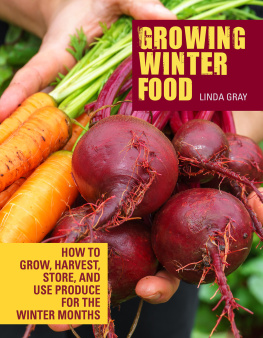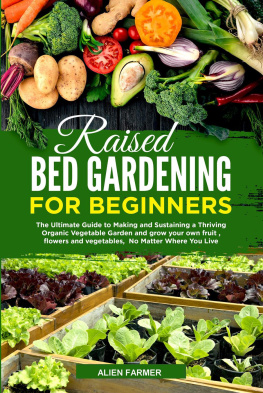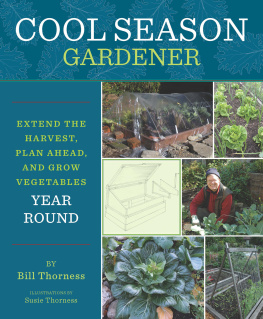The mission of Storey Publishing is to serve our customers by publishing practical information that encourages personal independence in harmony with the environment.
Edited by Carleen Madigan
Art direction and book design by Cynthia N. McFarland
Text production by Liseann Karandisecky and Theresa E. Wiscovitch
Cover and interior photography by Joseph De Sciose, except for Raylene Sampson: back cover, author photo; Niki Jabbour:
Illustrations by Elara Tanguy
Indexed by Christine R. Lindemer, Boston Road Communications
2011 by Niki Jabbour
Ebook production by Kristy L. MacWilliams
Ebook version 2.0
December 5, 2016
All rights reserved. No part of this book may be reproduced without written permission from the publisher, except by a reviewer who may quote brief passages or reproduce illustrations in a review with appropriate credits; nor may any part of this book be reproduced, stored in a retrieval system, or transmitted in any form or by any means electronic, mechanical, photocopying, recording, or other without written permission from the publisher.
The information in this book is true and complete to the best of our knowledge. All recommendations are made without guarantee on the part of the author or Storey Publishing. The author and publisher disclaim any liability in connection with the use of this information.
Storey books are available for special premium and promotional uses and for customized editions. For further information, please call 1-800-793-9396.
Storey Publishing
210 MASS MoCA Way
North Adams, MA 01247
www.storey.com
LIBRARY OF CONGRESS CATALOGING-IN-PUBLICATION DATA
Jabbour, Niki.
The year-round vegetable gardener / by Niki Jabbour.
p. cm.
Includes index.
ISBN 978-1-60342-568-1 (pbk. : alk. paper)
ISBN 978-1-60342-992-4 (hardcover : alk. paper)
1. Vegetable gardening. I. Title.
SB321.J33 2012
635dc23
2011024854
CONTENTS
Dedication
To Dany, Alex, and Isabelle, my favorite garden helpers!
To my parents, sisters, and in-laws. Thank you all for your continual support, encouragement, and willingness to be garden guinea pigs for a wide variety of crazy veggies.
ACKNOWLEDGMENTS
Id like to offer a big thank-you to everyone who made this book possible. I especially appreciate the hard work of my editor, Carleen Madigan, for the endless guidance and advice, as well as her ability to find the humor in any situation. Im also grateful to the photographer for the book, Joseph De Sciose, who can spot beauty in any scene from a pile of compost to a pesky slug.
Id also like to thank the talented team at Storey Publishing for their kind welcome and hard work art director Cindy McFarland, creative director Alethea Morrison, illustration coordinator Ilona Sherratt, and illustrator Elara Tanguy.
Last, but certainly not least, I owe a huge thank-you to all the gardeners who welcomed Carleen, Joe, and me into their gorgeous gardens: Rob and Brenda Franklin, Duff and Donna Evers, Yvon and Faye Brunet, Barry Dorey and Raylene Sampson, Alan and Darlene Soulsby, Larry and Peggy Brewster, George and Carol Knowles, Robert Cervelli and Susan Williams, John and Judy Risley, Peter Watson, Stephen and Sheila Archibald, Jean Snow and Bob Kropla, Thomas Generazio, Owen Bridge at Annapolis Seeds, and Windhorse Farm.
Foreword
BY ROGER DOIRON
Gardens, like other good ideas, have a way of growing in the most unlikely places. My first vegetable garden sprouted in my imagination while I was living on the top floor of an apartment building in Brussels, Belgium. Five stories up and with no land to call my own, I began planting the seeds of a new homegrown life by reading Living the Good Life, Helen and Scott Nearings back-to-the-land bible about homesteading on the coast of Maine.
The book helped me reconnect with my Maine roots, and with roots in general. But more than that, it helped expand my thinking about what was possible within the generous limits of Maines climate and soils. And, like a good book should, it also led me to other writers, notably Eliot Coleman, a Maine organic farmer who at the time was quietly redrawing the garden calendar through innovative season extension techniques and structures. Inspired by his experience and the Nearings, I moved back to Maine and grew greens right through a cold and snowy winter.
Now, more than ten years later, the arguments for growing vegetable gardens are stronger than ever, because of mounting concerns about health, climate change, the economy and food security. According to the United Nations Food and Agriculture Organization, were going to need to increase global food production by 70 percent over the next 40 years to keep pace with population growth. To meet this challenge, well not only need to grow new gardens but also more productive ones.
Fortunately, our knowledge base for how to do this is expanding, thanks to a new crop of gardeners who are pushing the limits of their climates and sharing their findings. Niki Jabbour is an important voice of this new generation of garden writers. She understands and shares in this helpful new book that extending the growing season is one of the easiest ways to increase productivity in the garden. We cant invent a new planet, but we can and must learn to use the resources of the current one more creatively, and that includes utilizing the sunshine, warmth, and water that each month offers.
... extending the growing season is one of the easiest ways to increase productivity in the garden. We cant invent a new planet, but we can and must learn to use the resources of the current one more creatively...
Whether youre a greenthumb or a greenhorn, Im sure youll learn many new things from Nikis experience growing vegetables year-round on the ocean-cooled coast of Nova Scotia. But the most valuable thing this book conveys is a sense of hope and personal empowerment. Although the global challenges we face are formidable, so are our resources. The good life is closer than we may think; we just need to know where and when to start digging, as well as when not to stop.
Roger Doiron is founder of Kitchen Gardeners International, a Maine-based nonprofit network of more than 20,000 individuals from 100 countries who are growing some of their own food and helping others to do the same. He eats year-round from his own garden on the coast of Maine.
Introduction
It all started with a row cover. Years ago, on an unexpectedly mild day in late November, I happened to wander over to the empty vegetable patch. I hadnt actually been to the garden since the garlic was planted in mid-October, thinking the season was over until the following spring. Yet as I strolled the pathways, I discovered that the bed where we had enjoyed arugula until early October was still going strong! I immediately headed back to the house for a bowl and then returned to pick a big salad for supper.
That night it snowed a few inches, but the next day, I went back up to the garden to see if the arugula had succumbed. It hadnt! Instead, the vigorous leaves were poking out of the snow, begging to be picked. I grabbed a few row covers from the garage that I typically used to protect the tomatoes after spring planting and placed them on top of the arugula patch. With that simple level of protection, we enjoyed arugula from the garden until after Christmas.

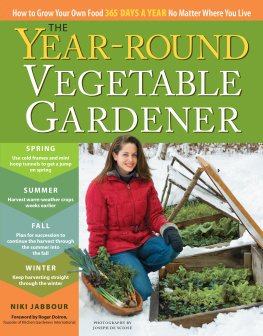

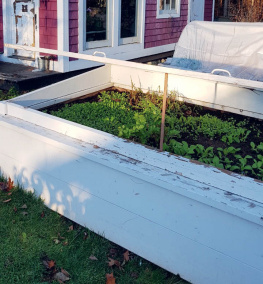
![Dowding - The Year-Round Vegetable Gardener’s Bible [7 Books in 1]](/uploads/posts/book/453239/thumbs/dowding-the-year-round-vegetable-gardener-s.jpg)

